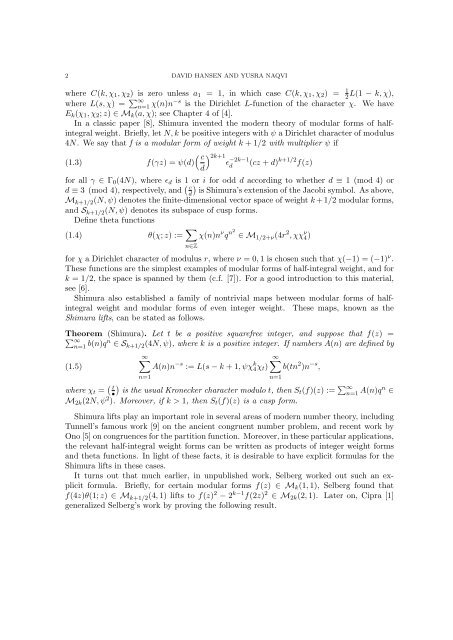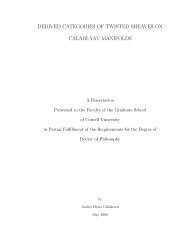Shimura lifts of half-integral weight modular forms - Department of ...
Shimura lifts of half-integral weight modular forms - Department of ...
Shimura lifts of half-integral weight modular forms - Department of ...
Create successful ePaper yourself
Turn your PDF publications into a flip-book with our unique Google optimized e-Paper software.
2 DAVID HANSEN AND YUSRA NAQVI<br />
where C(k, χ1, χ2) is zero unless a1 = 1, in which case C(k, χ1, χ2) = 1<br />
2L(1 − k, χ),<br />
where L(s, χ) = ∞ n=1 χ(n)n−s is the Dirichlet L-function <strong>of</strong> the character χ. We have<br />
Ek(χ1, χ2; z) ∈ Mk(a, χ); see Chapter 4 <strong>of</strong> [4].<br />
In a classic paper [8], <strong>Shimura</strong> invented the modern theory <strong>of</strong> <strong>modular</strong> <strong>forms</strong> <strong>of</strong> <strong>half</strong><strong>integral</strong><br />
<strong>weight</strong>. Briefly, let N, k be positive integers with ψ a Dirichlet character <strong>of</strong> modulus<br />
4N. We say that f is a <strong>modular</strong> form <strong>of</strong> <strong>weight</strong> k + 1/2 with multiplier ψ if<br />
<br />
c<br />
2k+1 (1.3) f(γz) = ψ(d) ɛ<br />
d<br />
−2k−1<br />
d (cz + d) k+1/2 f(z)<br />
for all γ ∈ Γ0(4N), where ɛd is 1 or i for odd d according to whether d ≡ 1 (mod 4) or<br />
d ≡ 3 (mod 4), respectively, and <br />
c<br />
d is <strong>Shimura</strong>’s extension <strong>of</strong> the Jacobi symbol. As above,<br />
Mk+1/2(N, ψ) denotes the finite-dimensional vector space <strong>of</strong> <strong>weight</strong> k + 1/2 <strong>modular</strong> <strong>forms</strong>,<br />
and Sk+1/2(N, ψ) denotes its subspace <strong>of</strong> cusp <strong>forms</strong>.<br />
Define theta functions<br />
(1.4) θ(χ; z) := <br />
χ(n)n ν q n2<br />
∈ M1/2+ν(4r 2 , χχ ν 4)<br />
n∈Z<br />
for χ a Dirichlet character <strong>of</strong> modulus r, where ν = 0, 1 is chosen such that χ(−1) = (−1) ν .<br />
These functions are the simplest examples <strong>of</strong> <strong>modular</strong> <strong>forms</strong> <strong>of</strong> <strong>half</strong>-<strong>integral</strong> <strong>weight</strong>, and for<br />
k = 1/2, the space is spanned by them (c.f. [7]). For a good introduction to this material,<br />
see [6].<br />
<strong>Shimura</strong> also established a family <strong>of</strong> nontrivial maps between <strong>modular</strong> <strong>forms</strong> <strong>of</strong> <strong>half</strong><strong>integral</strong><br />
<strong>weight</strong> and <strong>modular</strong> <strong>forms</strong> <strong>of</strong> even integer <strong>weight</strong>. These maps, known as the<br />
<strong>Shimura</strong> <strong>lifts</strong>, can be stated as follows.<br />
<br />
Theorem (<strong>Shimura</strong>). Let t be a positive squarefree integer, and suppose that f(z) =<br />
∞<br />
n=1 b(n)qn ∈ Sk+1/2(4N, ψ), where k is a positive integer. If numbers A(n) are defined by<br />
∞<br />
(1.5)<br />
A(n)n −s := L(s − k + 1, ψχ k ∞<br />
4χt) b(tn 2 )n −s ,<br />
n=1<br />
where χt = <br />
t<br />
• is the usual Kronecker character modulo t, then St(f)(z) := ∞ n=1 A(n)qn ∈<br />
M2k(2N, ψ2 ). Moreover, if k > 1, then St(f)(z) is a cusp form.<br />
<strong>Shimura</strong> <strong>lifts</strong> play an important role in several areas <strong>of</strong> modern number theory, including<br />
Tunnell’s famous work [9] on the ancient congruent number problem, and recent work by<br />
Ono [5] on congruences for the partition function. Moreover, in these particular applications,<br />
the relevant <strong>half</strong>-<strong>integral</strong> <strong>weight</strong> <strong>forms</strong> can be written as products <strong>of</strong> integer <strong>weight</strong> <strong>forms</strong><br />
and theta functions. In light <strong>of</strong> these facts, it is desirable to have explicit formulas for the<br />
<strong>Shimura</strong> <strong>lifts</strong> in these cases.<br />
It turns out that much earlier, in unpublished work, Selberg worked out such an explicit<br />
formula. Briefly, for certain <strong>modular</strong> <strong>forms</strong> f(z) ∈ Mk(1, 1), Selberg found that<br />
f(4z)θ(1; z) ∈ M k+1/2(4, 1) <strong>lifts</strong> to f(z) 2 − 2 k−1 f(2z) 2 ∈ M2k(2, 1). Later on, Cipra [1]<br />
generalized Selberg’s work by proving the following result.<br />
n=1
















